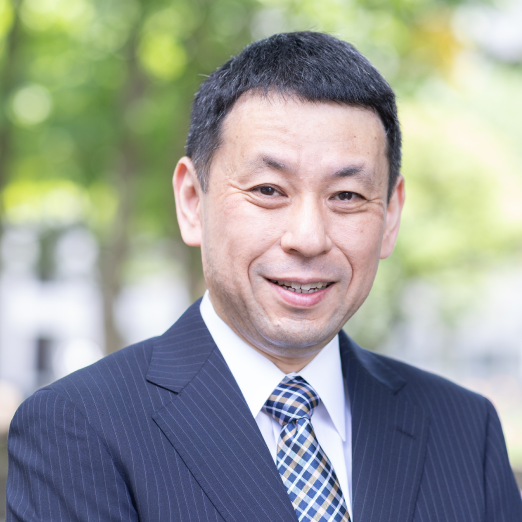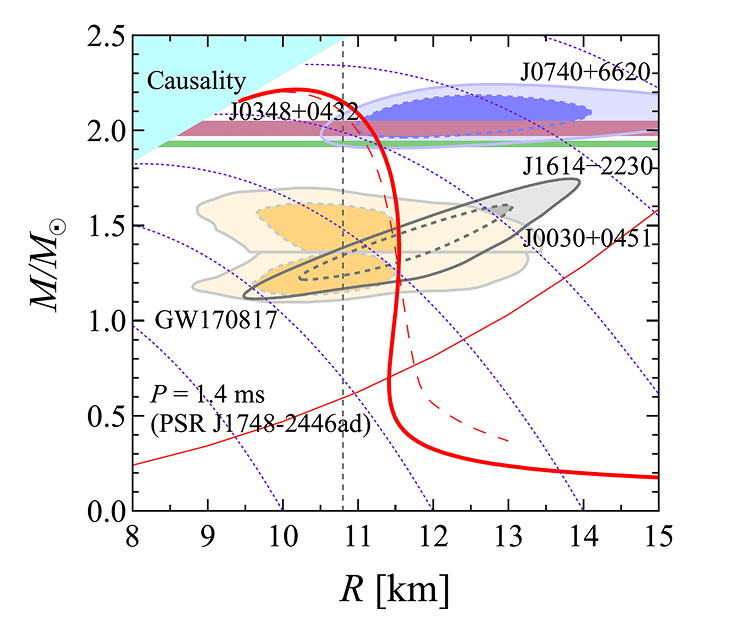
鷹野 正利 教授
TAKANO, Masatoshi
専門分野
理論核物理学
無限に大きい核物質の研究と 天体物理学への応用
研究テーマ
核物質状態方程式の研究と天体物理学への応用/強い粒子間相関をもつFermi粒子系に対する変分法
キーワード
核物質の状態方程式, 変分法, 中性子星と重力崩壊型超新星爆発
LINKS
RESEARCH OVERVIEW
研究概要
原子核は核子(陽子と中性子)が核力という力で結合している系で、現在約3000種類以上の原子核が実験的に知られています。それらの膨大な実験データの多くについて、まだ理論的に十分な説明がなされていません。 原子核構造研究の困難さは2つの側面を持ちます。1つは、核力の複雑さです。核力は強い短距離引力と斥力芯から成り、また核子のスピンや速度等によって変化する、非常に複雑な力です。さらに、3つの核子の間に働く3体力も重要であると考えられています。 もう1つは、多体問題的側面です。一般に多体問題を解く事は困難ですが、例えば鉛の原子核208Pbは、82個の陽子と126個の中性子から成り、その構造を知るためには208体問題を解かなければなりません。現状で、これを厳密に解く事は不可能です。
そこで我々は、無限個の核子から成る無限に大きい仮想的な原子核(以下では核物質と呼びます)を考えます。そして、主に変分法を用いて、核物質の多体問題的研究を行う事により、核物質の観点から原子核の大局的性質を理解する事を目指します。 核物質エネルギーの理論計算により、いわゆる核物質の状態方程式(EOS)が得られます。計算された核物質EOSの信頼性を調べるために、我々は宇宙に目を向けます。
「仮想的」な無限に大きい核物質は、中性子星という天体の姿で存在します。中性子星は超高密度の天体で、非常に強い自己重力に対して、内部核物質の硬さが星を支えています。よって、中性子星の構造研究には、核物質EOSの情報が必要です。また逆に、中性子星観測結果との比較で、計算された核物質EOSの信頼性が確認できます。さらに、恒星の進化の最終段階で起こる超新星爆発のきっかけも、核物質の硬さにあると考えられ、そのような天体現象の理解には、核物質EOSの情報が不可欠です。 このように核物質EOSは、原子核物理学、天体物理学で重要な役割を果たしますが、これを実験的に決定する事は困難で、信頼性の高い理論多体計算が必要です。我々のグループでは、こうした中性子星、超新星爆発等の天体現象の理論的研究に適用可能な核物質EOSの研究を行っています。

MESSAGE to STUDENTS
学生へのメッセージ
原子核物理学はミクロな世界であるので量子力学をふんだんに使って研究するだけでなく、中性子星のようなマクロな天体とも密接に関連している、非常に魅力的な研究分野です。興味がある人は是非連絡をしてください。
学歴・経歴
1993年 早稲田大学理工学総合研究センター助手
1994年 早稲田大学大学院理工学研究科博士後期課程退学 博士(理学)早稲田大学 取得
1997年 早稲田大学理工学総合研究センター専任講師
1999年 早稲田大学理工学総合研究センター助教授
2006年 早稲田大学理工学総合研究センター教授
2008年 早稲田大学先進理工学部教授
所属学協会
- 日本物理学会
- アメリカ物理学会

TAKANO, Masatoshi
Professor
Field of study
Theoretical nuclear physics
Theoretical study of the nuclear equation of state
Research Themes
The nuclear equation of state and its application to astrophysics / Variational method for strongly correlated fermion systems
Keywords
Equation of state for nuclear matter, Variational method, Neutron stars and core-collapse supernovae
RESEARCH OVERVIEW
The atomic nucleus is a quantum mechanical system composed of nucleons (protons and neutrons) that interact through nuclear and Coulomb forces. One of its fundamental properties is the “saturation property of nuclear forces,” which indicated that the nucleon number densities inside nuclei and binding energies per nucleon are nearly constant. To explain this property quantitatively, the Schrödinger equation for the atomic nucleus must be solved. However, it remains unsolved because of the uncertainty in the nuclear Hamiltonian, particularly in the nuclear forces. Furthermore, solving the quantum many-body problem is challenging. To overcome this difficulty, we study the quantum variational many-body theory for hypothetical infinitely large nuclear matter.
Infinitely large nuclear matter exists in neutron stars, which are compact objects with masses about twice that of the Sun (or slightly less), and radii of about 10 km. The interior of a neutron star is high-density nuclear matter. The stiffness of the interior nuclear matter supports the neutron star against its strong self-gravity. Thus, the structure of a neutron star is determined by the stiffness of its interior nuclear matter or, more precisely, by the equation of state (EOS) of nuclear matter. Furthermore, owing to recent developments in neutron star observations, various constraints have been imposed on the nuclear EOS. We are currently studying the neutron star structure in relation to the nuclear EOS obtained using our variational method.
The nuclear EOS is crucial for investigating core-collapse supernovae and other high-energy astrophysical phenomena, such as black hole formation and neutron star mergers. To study these phenomena with numerical hydrodynamic simulations, an EOS of nuclear matter that covers an extremely wide range of densities, temperatures, and proton fractions is necessary. Several years ago, we constructed a new nuclear EOS appropriate for these phenomena based on the variational many-body theory. We are currently improving the EOS using a more sophisticated variational many-body technique.

MESSAGE to STUDENTS
The atomic nucleus is an extremely small system that is fully governed by quantum mechanics. Additionally, nuclear physics encompasses huge astrophysical objects, such as neutron stars. If you are interested in this fascinating research field, please contact us.
Education and Career
1993 Advanced Research Institute for Science and Engineering, Waseda University, Reserach Associate
1994 D. Sci. Physics, Waseda University
1997 Advanced Research Institute for Science and Engineering, Waseda University, Assistant Professor
1999 Advanced Research Institute for Science and Engineering, Waseda University, Associate Professor
2006 Advanced Research Institute for Science and Engineering, Waseda University, Professor
2008 Department of Physics, Waseda University, Professor
Professional Memberships
- The Physical Society of Japan
- American Physical Society
